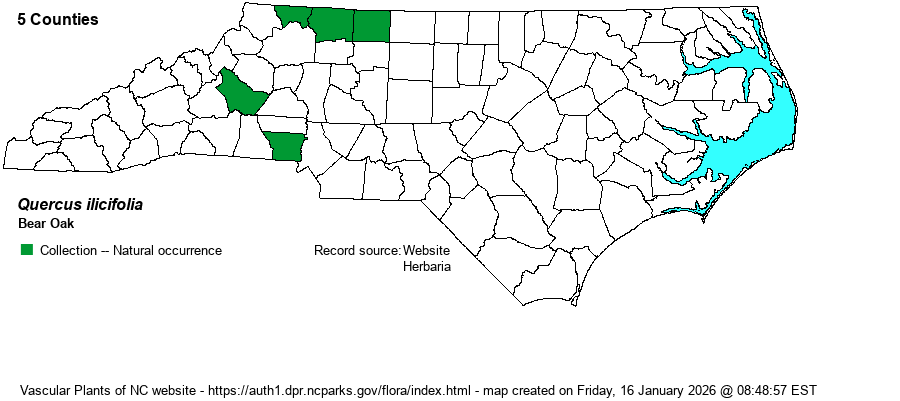| Author | Wangenheim | |
| Distribution | Found only at a few scattered locations in the western Piedmont and extreme northern Mountains. Known from Alleghany, Surry, and Stokes counties near the VA border; and Burke and Gaston counties in the southwestern Piedmont. Few recent records have been reported.
A rather narrow north-south range, occurring from ME and NY south only in Atlantic states (plus WV) to western NC. No records known for OH or TN, and just one site in eastern KY.
| |
| Abundance | Rare and extremely local in the western Piedmont (on monadnocks) and the adjacent Blue Ridge in Alleghany County. The likelihood of discovering new sites is rather low. Fire-suppression has been one reason for its lack of range and population expansion; this species does well in frequently burned areas. This is a State Endangered species. | |
| Habitat | In NC it is restricted to thin, dry, acidic soils at the edge of rock outcrops, granitic domes, and exposed ridges -– typically near or at the highest elevations on a given ridge or mountain. Note that it does not occur in the middle or higher elevations, per se, in the state, but often at some of the higher elevations in Piedmont ranges. It can occur on some pine/oak heath stands and other barren slopes. |
| Phenology | Flowers from late April to June, and fruits in August of the second year. | |
| Identification | Thankfully for the observer, most sites of this rare species in NC are found in conservation areas, where people can become familiar with it. This is a small deciduous tree, barely reaching 15-20 feet tall. Farther north it can occur in dense thicket-like stands, but in NC it is usually found only as scattered individuals or in very small stands. The leaves are about 4 inches long, a bit smaller than for most oaks, and typically have about 5 rather shallow/low lobes, each with a bristle tip. The sinuses are somewhat rounded and not deeply cut. The leaves are a rather obovate (top-heavy) shape that is a bit different from all other NC oaks. Nearly all other oaks in the “red oak group” growing in the western Piedmont have deeper sinuses and larger leaves -– such as Northern Red Oak (Q. rubra), Scarlet Oak (Q. coccinea), and Black Oak (Q. velutina) -– and grow to a much greater height. | |
| Taxonomic Comments | None
| |
| Other Common Name(s) | Scrub Oak | |
| State Rank | S2 | |
| Global Rank | G5 | |
| State Status | E | |
| US Status | | |
| USACE-agcp | | |
| USACE-emp | | |

